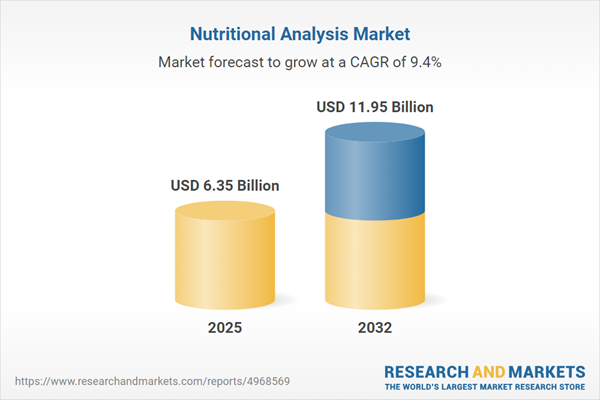Speak directly to the analyst to clarify any post sales queries you may have.
Senior decision-makers face an evolving nutritional analysis market shaped by shifting regulatory demands, rapid digital transformation, and increased expectations for operational flexibility. Today, organizations seeking long-term growth and compliance must prioritize actionable insights, technology investments, and robust operational strategies to support resilient decision-making.
Nutritional Analysis Market Snapshot: Key Trends and Growth Dynamics
The nutritional analysis market recorded a value of USD 5.80 billion in 2024 and is anticipated to expand at a 9.44% compound annual growth rate. Forward-looking estimates project the market will reach USD 6.35 billion by 2025 and USD 11.95 billion by 2032. This upward trajectory is spurred by the integration of advanced digital laboratory tools, automation, and data transparency across supply chains. Industry stakeholders increasingly adopt streamlined laboratory management and workflow systems in response to evolving regulations, ensuring quality, traceability, and compliance. Intensified regulatory oversight and accelerating digitalization are prompting organizations to seek high-quality, accurate analyses as the backbone of strategic business planning.
Nutritional Analysis Market Scope & Segmentation
The market spans a diverse spectrum of technologies, disciplines, and service frameworks. Understanding clear segmentation enables targeted business strategies, optimized resource allocation, and the development of tailored solutions for varied operational demands and compliance challenges across global markets.
- Technique: Gas chromatography, high performance liquid chromatography, mass spectrometry, and spectroscopy equip laboratories with tools for effective compliance audits, advanced analytics, and data-driven decision-making.
- Service: Calibration, consulting, equipment rental, and multiple testing options allow flexible responses to dynamic sector requirements and client needs.
- Application: Nutritional labeling, regulatory compliance, R&D, shelf-life testing, and quality assurance facilitate visibility and efficient adoption of international standards in food, academia, and pharmaceuticals.
- End User: Academic institutions, food and beverage manufacturers, regulatory agencies, and pharmaceutical firms leverage analytical solutions tailored for unique reporting protocols and compliance frameworks.
- Sample Type: Analytical procedures address gaseous, liquid, semi-solid, and solid samples, reinforcing safety and quality throughout raw material sourcing and finished product distribution.
- Distribution Channel: Direct sales, distributor partnerships, and online procurement deliver adaptive sourcing models aligned to enterprise needs, geographic factors, and logistical timelines.
- Region: Industry participants address compliance and market demands in the Americas, Europe, Middle East & Africa, and Asia-Pacific, tailoring local solutions to enhance presence and regulatory adaptation.
- Company Coverage: Leading contributors such as Eurofins Scientific SE, SGS SA, Bureau Veritas SA, Intertek Group plc, ALS Limited, Mérieux NutriSciences Sàrl, NSF International, TÜV SÜD AG, UL LLC, and Laboratory Corporation of America Holdings drive technological advancement and industry standards.
Key Takeaways for Strategic Decision-Makers
- Laboratory analytics leveraging data provide organizations with a proactive edge, strengthening regulatory responsiveness and preempting emerging compliance challenges.
- Trusted service providers and solution partners create more robust supply chains, smoothing transitions during audits and facilitating regulatory reviews.
- Switching to digital laboratory platforms greatly reduces manual errors and accelerates the delivery of accurate analysis for geographically dispersed operations.
- Broadening service offerings to include consulting and calibration enables organizations to meet complex client demands and better address market variability.
- Advanced digital management systems empower leaders with on-demand insights, enabling timely and informed decisions about suppliers, regulatory updates, and market shifts.
Tariff Impact: US Policy Effects on Supply Chains
Recent US tariff changes have increased the costs of essential laboratory equipment and consumables, directly influencing service provider budget planning in the nutritional analysis industry. To mitigate these cost pressures, organizations focus on building stronger relationships with domestic suppliers, diversifying procurement strategies, and adopting integrated service agreements. Effective inventory management also helps maintain operational continuity and adaptability amid fluctuating policy environments.
Methodology & Data Sources
This report integrates findings from peer-reviewed publications, authoritative industry databases, and regulatory sources. Direct input from laboratory executives, technical professionals, and financial analysts supports the practical validation and relevance of conclusions for senior-level decision-makers facing shifting market conditions.
Why This Report Matters for Senior Decision-Makers
- Offers a strategic guide to navigating regulatory and compliance evolution while reducing operational risks through informed resource deployment.
- Facilitates forward-thinking planning by aligning laboratory investment with emerging industry and technology trends to foster organizational resilience.
- Enables leadership to proactively adapt procurement and operations in response to changing market and policy environments with confidence and accuracy.
Conclusion
Continued advancements in analytical technology and expanding service frameworks equip organizations to adapt and grow amid market transformation. This report provides a reliable foundation for making strategic decisions and meeting evolving regulatory requirements effectively.
Additional Product Information:
- Purchase of this report includes 1 year online access with quarterly updates.
- This report can be updated on request. Please contact our Customer Experience team using the Ask a Question widget on our website.
Table of Contents
3. Executive Summary
4. Market Overview
7. Cumulative Impact of Artificial Intelligence 2025
Companies Mentioned
The companies profiled in this Nutritional Analysis market report include:- Eurofins Scientific SE
- SGS SA
- Bureau Veritas SA
- Intertek Group PLC
- ALS Limited
- Mérieux NutriSciences Sàrl
- NSF International
- TÜV SÜD AG
- UL LLC
- Laboratory Corporation of America Holdings
Table Information
| Report Attribute | Details |
|---|---|
| No. of Pages | 186 |
| Published | November 2025 |
| Forecast Period | 2025 - 2032 |
| Estimated Market Value ( USD | $ 6.35 Billion |
| Forecasted Market Value ( USD | $ 11.95 Billion |
| Compound Annual Growth Rate | 9.4% |
| Regions Covered | Global |
| No. of Companies Mentioned | 11 |









